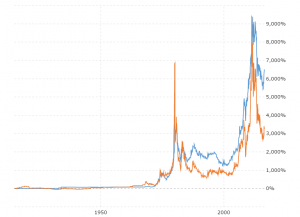2019 Native American $1-coin Design Revealed
2019 will be the 10th year in the on-going Native American Indian $1-coin series. It began back in 2009 with the Three Sisters – the traditional crops of corn, squash and beans. 2019 takes us as far away from the fields and the earth as possible, celebrating the role of Native Americans in NASA and the Space Program.
The central figure in the design for the reverse of the coin is Mary Golda Ross, a renowned engineer closely involved in aerospace design. She was born in Oklahoma in 1908, and became the first Native American female engineer, and the first female engineer ever employed by Lockheed. She was a Cherokee, and she originally studied to become a teacher, working for 9 years in schools during the Great Depression. She became a statistical clerk with the Department of Indian Affairs, gained a master’s degree, and then moved to California, where she joined Lockheed in 1942. She worked on high-speed aircraft design, and then, unusually for the time, she was kept on by Lockheed when WWII ended, and sent to UCLA to study engineering.
In top-secret sections of Lockheed, she worked on interplanetary travel, earth-orbiting vehicles and early satellite designs. She was one of the authors of the NASA Planetary Flight Handbook Vol. III, an early guide for space travel to Mars and Venus. In the 1960s she worked on the Polaris, Poseidon and Trident missiles, and the Agena spacecraft for the Gemini and Apollo space programs. She retired in 1973 but remained prominent in issues of women and science, as well as Native affairs. After a long and important life, she died in 2008.
The coin reverse shows Mary G. Ross in the foreground, working on papers. Behind her is an Apollo rocket taking off, with a cloud of smoke billowing from it. In the smoke is an equation for escape velocity, V2∞ = V2– 2μ/r, just one of the thousands used to calculate travel in space. Gripping the broad border of the design, as if gazing down from above, is a NASA astronaut walking in space, to represent Native American Astronauts. The most prominent is John B. Harrington, the first Native American to walk in space, which he did in 2002. A member of the Chichasaw nation, he today works to encourage STEM studies by Native Americans.
In the background are a scattering of stars across the vastness of outer space, and the words, UNITED STATES OF AMERICA and $1. The designer Emily Damstra, a science illustrator who has already created numerous coins and medals for the US Mint, and part of the Mint’s Artistic Infusion Program, created the design for the reverse, and the well-established Mint Sculptor-Engraver Joseph Menna turned that design into a coin.
The obverse is the now well-known image, used throughout the series, which shows Sacagawea, guide to the Lewis & Clarke Expedition, carrying her infant son, Jean Baptiste. LIBERTY and IN GOD WE TRUST complete the obverse side. The year of issue (2019), E PLURIBUS UNUM and the mint mark are engraved around the edge.

















I thought Mr. Willis S. Jenkins, Jr. Created the formula for the new 2019 Gold $1 Piece. If this is the case then why isnt his name mentioned in the description.
Also how do I order a roll of these coins.